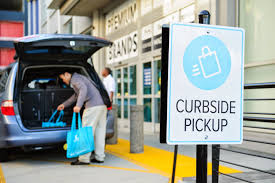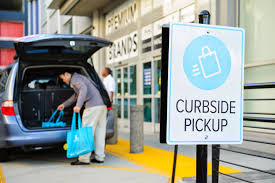
Curbside pickup is a differentiation strategy that is being used by some veteran supermarket operators to give a fight to Amamzon.com in the U.S. which is seeking to use the home delivery strategy to topple the U.S. grocery market.
The drive through service for burgers and coffee has been an all time favorite for Americans. And this formula is being tweaked by Kroger Co and Walmart Inc.
Investments in online systems that give customers the convenience of ordering ahead for groceries at the local store have been made by these companies. In what is the grocery version of the pizza delivery system, these grocers use their parking lots for customers to pick up groceries after workers pick and pack the ordered products. And because customers drive into the parking lot themselves, this model turns out to be less costly for the grocers compared to the home delivery system. This is also an advantage for the shoppers because they can avoid the cord and the long line and skip the worry of the melting ice-cream delivered to their home and if they are not around to collect them immediately.
And this delivery strategy is being bet on by traditional retailers as they continue to fight against the rising band of online grocers who offer home deliveries.
Traditional retailers are being faced with tough challenges from new companies like meal-kit company Blue Apron and organic food seller Thrive Market. Sale of packaged goods like pasta and diapers has been the mainstay for Amazon as the largest online retailer in the U.S. with 18 percent market share in a market that is valued at $12.6 billion. According to market research firm Packaged Facts, this market is anticipated to grow to $41.7 billion by 2022 and Amazon is a major player in this sphere.
But the challenge of delivering fresh produce, meat, dairy and other perishables has been tricky even for Amazon. No major mark has been made by the AmazonFresh service that the company had began about a decade ago.
The acquisition of the upscale grocery chain Whole Foods by Amazon earlier this year is an attempt of the retail giant to make another attempt to increase influence in the grocery market. the deal cost Amazon $13.7 billion. Little has been said by Amazon about its plans for Whole Foods. However, experts believe that Amazon will make use of the 450 locations of Whole Foods for distribution hubs for the home delivery service.
Some new and unique strategies are being used by old-line players to address the challenge of Amazon. Delivery variations are the bet for Kroger and Walmart. Btu for the online evolution of the industry, delivery would be the sweet post as being bet by the companies. The service is being rolled out in thousands of their stores.
“The way people are going to shop for groceries is going to be curbside, not delivery,” said Jason Goldberg, a senior vice president at digital marketing firm SapientRazorfish.
This channel is also being eyed by Amazon. Analysts are of the view that Amazon would also use Whole Foods for the pickup strategy as it has already tested the strategy in Seattle via AmazonFresh.
But real estate can be the key for the traditional retailers to combat the challenge, says researcher Packaged Facts.
“Companies such as Walmart and Kroger have the advantage, because they already have stores all over the country in both urban and rural settings,” it said in a recent report.
(Source:www.reuters.com)
The drive through service for burgers and coffee has been an all time favorite for Americans. And this formula is being tweaked by Kroger Co and Walmart Inc.
Investments in online systems that give customers the convenience of ordering ahead for groceries at the local store have been made by these companies. In what is the grocery version of the pizza delivery system, these grocers use their parking lots for customers to pick up groceries after workers pick and pack the ordered products. And because customers drive into the parking lot themselves, this model turns out to be less costly for the grocers compared to the home delivery system. This is also an advantage for the shoppers because they can avoid the cord and the long line and skip the worry of the melting ice-cream delivered to their home and if they are not around to collect them immediately.
And this delivery strategy is being bet on by traditional retailers as they continue to fight against the rising band of online grocers who offer home deliveries.
Traditional retailers are being faced with tough challenges from new companies like meal-kit company Blue Apron and organic food seller Thrive Market. Sale of packaged goods like pasta and diapers has been the mainstay for Amazon as the largest online retailer in the U.S. with 18 percent market share in a market that is valued at $12.6 billion. According to market research firm Packaged Facts, this market is anticipated to grow to $41.7 billion by 2022 and Amazon is a major player in this sphere.
But the challenge of delivering fresh produce, meat, dairy and other perishables has been tricky even for Amazon. No major mark has been made by the AmazonFresh service that the company had began about a decade ago.
The acquisition of the upscale grocery chain Whole Foods by Amazon earlier this year is an attempt of the retail giant to make another attempt to increase influence in the grocery market. the deal cost Amazon $13.7 billion. Little has been said by Amazon about its plans for Whole Foods. However, experts believe that Amazon will make use of the 450 locations of Whole Foods for distribution hubs for the home delivery service.
Some new and unique strategies are being used by old-line players to address the challenge of Amazon. Delivery variations are the bet for Kroger and Walmart. Btu for the online evolution of the industry, delivery would be the sweet post as being bet by the companies. The service is being rolled out in thousands of their stores.
“The way people are going to shop for groceries is going to be curbside, not delivery,” said Jason Goldberg, a senior vice president at digital marketing firm SapientRazorfish.
This channel is also being eyed by Amazon. Analysts are of the view that Amazon would also use Whole Foods for the pickup strategy as it has already tested the strategy in Seattle via AmazonFresh.
But real estate can be the key for the traditional retailers to combat the challenge, says researcher Packaged Facts.
“Companies such as Walmart and Kroger have the advantage, because they already have stores all over the country in both urban and rural settings,” it said in a recent report.
(Source:www.reuters.com)





